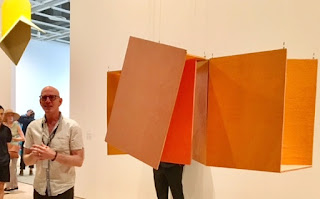Hélio Oiticica: To Organize Delirium exhibit was going to be a bit different from typical museum fare. I walked around the galleries while waiting for the tour to start and was, quite frankly, baffled. Why were there people enjoying a game of pool? Why were people lying in hammocks with Jimi Hendrix playing in the background? It would all be revealed in due course.
 |
The pool table is thought to be a
reference to van Gogh's "Night Café."
The sound of the balls hitting one another
also engages another different sense.
|
 |
| Wearing a Parangolé |
As interesting as these works were, they were just the beginning. Participants became an even more integral part of the art with Oiticica's Parangolés. The pieces are "mobile sculptures" made of cotton, plastic, and other materials. I happily donned one but drew the line at dancing the samba as Oiticia intended.
 |
| Tropicalia |
Our docent once again put the work in context. "Think of 1960s London where Tropicalia was first introduced," he said. "Men who visited museums wore suits and ties and had to roll their pant legs up before wading in." I loved the visual.
 |
| Jimi Hendrix "Cocoon" |
Oiticica's fertile imagination envisioned nine "environmental pieces." Only five were realized during his lifetime, including a "nest" comprised of mattresses on which participants lie while listening to music and viewing pictures streamed onto the walls. Oititica intended for participants to file their nails while lying on the mattresses, creating cocaine-like flecks of white. (The Whitney skipped that component.)
But I preferred the hammock "cocoons" to the nests. The images on the walls and ceiling in the room were photographs on which Oititica had painted using cocaine for the pigment. Jimi Hendrix music enveloped us. It makes no sense, but the experience was extremely relaxing. In the hammock next to me laid a mother nestling with her small child. I felt like I could have rested there all afternoon, but I had places to go and people to see.
And so concluded another satisfying visit to the Whitney. Once again, my concept of art had been pushed beyond its previous limits with a knowledgeable docent leading the way. I loved it.




Thank you for your great descriptions of the "art happenings".
ReplyDeleteYou make one feel as if they were right there with you.
Thanks so much! That's my goal.
ReplyDelete